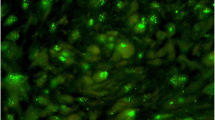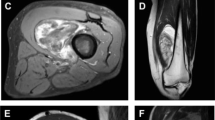Abstract
Background
To identify the best surgical approach to atypical lipomatous tumors we reviewed 171 patients who underwent surgery at two sarcoma referral centers with different surgical policies.
Methods
Of the 151 patients (88 %) with primary tumors, 95 were treated at Institution A and 76 were treated at Institution B. At Institution A, a wide surgical resection, including a slight cuff of soft tissue around the mass, was adopted, which was defined as marginal resection (MR) according to the Enneking classification. At Institution B, a simple tumor resection (SR), according to the Enneking classification, was employed. En bloc surgical resection was the goal in both centers. The primary outcomes of the study were local recurrence-free survival (LRFS), incidence of secondary dedifferentiation at recurrence, and presence of residual tumor after re-excision.
Results
Sixteen patients (9 %) had local recurrence. The 10-year LRFS was 82 %. No cases of secondary dedifferentiation were observed. Residual tumor after re-excision was found in 46 % of cases. In univariate analysis, sclerosing subtype, tumor rupture, and SR were unfavorable prognostic factors for LRFS. Sclerosing subtype and tumor rupture were independent prognostic factors for LRFS in multivariate analysis. SR was significantly associated with tumor rupture.
Conclusions
Sclerosing subtype and tumor rupture are unfavorable prognostic factors for local recurrence. MR is associated with a lower risk of tumor rupture than SR. Neurovascular and major muscle resections are not necessary in principle. Re-excision after unplanned surgery is not always mandatory. A preoperative core needle biopsy could be useful in identifying the sclerosing subtype.



Similar content being viewed by others
References
Kooby DA, Antonescu CR, Brennan MF, et al. Atypical lipomatous tumor/well-differentiated liposarcoma of the extremity and trunk wall: importance of histological subtype with treatment recommendations. Ann Surg Oncol. 2004;11:78-84.
Coindre JM, Pédeutour F, Aurias A, et al. Well-differentiated and dedifferentiated liposarcomas. Virch Arch. 2010;456:167-79.
Rubin BP, Fletcher CDM. The cytogenetics of lipomatous tumours. Histopathology. 1997;30:507-511.
Mystakidou K, Panagiotou I, Brountzos E, Kouloulias V, et al. Well-differentiated hand liposarcoma with bone metastases treated successfully with zoledronic acid. Onkologie. 2011;34:706-709.
Gronchi A, Lo Vullo S, Colombo C, et al. Extremity soft tissue sarcoma in a series of patients treated at a single institution: local control directly impacts survival. Ann Surg. 2010;251:512–517.
Enneking WF. A system of staging musculoskeletal neoplasms. Clin Orthop. 1980;153:106–120.
Enneking WF, Spanier S, Goodman M, et al. A system for the surgical staging of musculoskeletal sarcoma. Clin Orthop. 1986;204:9-24, ASP 2004;11:476-82.
Gerrand CH, Wunder JS, Kandel RA, et al. The influence of anatomic location on functional outcome in lower-extremity soft tissue sarcoma. Ann Surg Oncol. 2004;11(5):476–482.
Dalal KM, Kattan MW, Antonescu CR, et al. Subtype specific prognostic nomogram for patients with primary liposarcoma of the retroperitoneum, extremity, or trunk. Ann Surg. 2006;244:381–191.
Cahlon O, Brennan MF, Jia X, et al. A postoperative nomogram for local recurrence risk in extremity soft tissue sarcomas after limb-sparing surgery without adjuvant radiation. Ann Surg. 2012;255:343–347.
Eilber FC, Brennan MF, Riedel E, et al. Prognostic factors for survival in patients with locally recurrent extremity soft tissue sarcomas. Ann Surg Oncol. 2008;12:228–236.
Fiore M, Casali PG, Miceli R, et al. Prognostic effect of re-excision in adult soft tissue sarcoma of the extremity. Ann Surg Oncol. 2006;13:110–117.
Weaver J, Rao P, Goldblum JR, et al. Can MDM2 analytical tests performed on core needle biopsy be relied upon to diagnose well-differentiated liposarcoma? Mod Pathol. 2010;23:1301–1306.
Arrigoni G, Doglioni G. Atypical lipomatous tumor: molecular characterization. Curr Opin Oncol. 2004; 16:355–358.
Trotti A, Colevas AD, Setser A, et al. CTCAE v3.0: development of a comprehensive grading system for the adverse events of cancer treatment. Semin Radiat Oncol. 2003; 13:176–181.
National Cancer Institute, National Institutes of Health, US Department of Health and Human Services. Common Terminology Criteria for Adverse Events (CTCAE) version 4.0. Published 28 May 2009; revised version 4.03 June 14, 2010. Available from: http://evs.nci.nih.gov/ftp1/CTCAE/CTCAE_4.03_2010-06-14QuickReference_5x7.pdf2010-06-14QuickReference_5x7.pdf. Accessed 20 May 2013.
Fletcher CDM, Bridge JA, Hogendoorn P et al. WHO classification of tumours of soft tissue and bone : IARC, Lyon, 2013.
Coindre JM, Trojani M, Contesso G, et al. Reproducibility of a histopathologic grading system for adult soft tissue sarcoma. Cancer. 1986;58:306–309.
Mussi C, Collini P, Miceli R, et al . The prognostic impact of dedifferentiation in retroperitoneal liposarcoma: a series of surgically treated patients at a single institution. Cancer. 2008;113:1657–1665.
Mavrogenis AF, Lesensky J, Romagnoli C, et al. Atypical lipomatous tumor/well-differentiated liposarcomas: clinical outcome of 67 patients. Orthopedics. 2011;34:893–898.
Gutierrez JC, Perez EA, Moffat FL, et al. Should soft tissue sarcomas be treated at high-volume centers? An analysis of 4205 patients. Ann Surg. 2007;245:952–958.
Smith CA, Martinez SR, Tseng WH, et al. Predicting survival for well-differentiated liposarcoma: the importance of tumor location. J Surg Res. 2012;175:12–17.
Kubo T, Sugita T, Shimose S, Arihiro K, et al. Conservative surgery for well-differentiated liposarcomas of the extremities adjacent to major neurovascular structures. Surg Oncol. 2006;15:167–171.
Kimura H, Dobashi Y, Nojima T, et al. Utility of fluorescence in situ hybridization to detect MDM2 amplification in liposarcomas and their morphological mimics. Int J Clin Exp Pathol. 2013;6:1306–1316.
Einarsdóttir H, Skoog L, Söderlund V, et al. Accuracy of cytology for diagnosis of lipomatous tumors: comparison with magnetic resonance and computed tomography findings in 175 cases. Acta Radiol. 2004;45:840–846.
Author information
Authors and Affiliations
Corresponding author
Rights and permissions
About this article
Cite this article
Mussi, C.E., Daolio, P., Cimino, M. et al. Atypical Lipomatous Tumors: Should They be Treated Like Other Sarcoma or Not? Surgical Consideration from a Bi-Institutional Experience. Ann Surg Oncol 21, 4090–4097 (2014). https://doi.org/10.1245/s10434-014-3855-7
Received:
Published:
Issue Date:
DOI: https://doi.org/10.1245/s10434-014-3855-7




